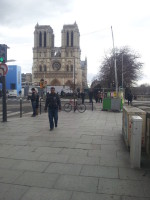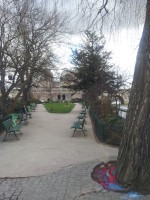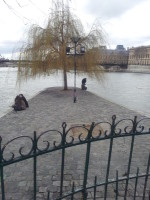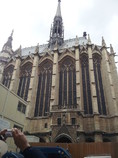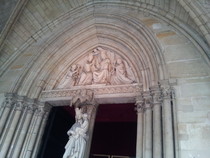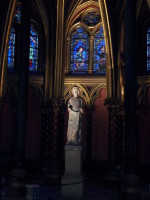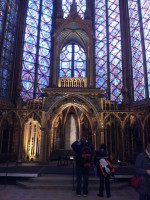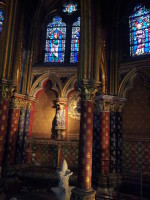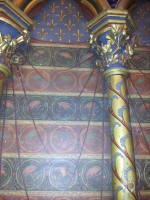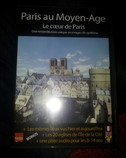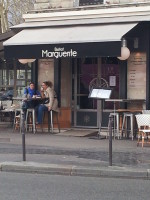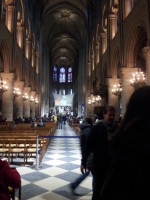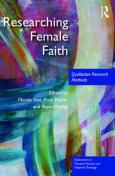Travel Log Tuesday 19th March 2013
After breakfasting on fresh bread and croissants we decided that today we would "do our own thing" and then meet up later for drinks and dinner.
Tom was going off to explore Monmartre and Pigalle. I had the Sainte Chapelle and the rest of the Île de la Cité on my list of must-sees. So we walked together to the west front of Notre Dame and parted. I took note of the present occupants of the façade – intact statues of a 19th century “galerie des rois” (gallery of kings). I hurried off to find the entrance to Sainte Chapelle. After initial confusion, I learnt that the queue I had seen was actually for the Palais de Justice and that the chapel was closed until 2.15pm. In my ignorance I hadn’t realized that this 13th century jewel in Saint Louis’ crown was now enclosed within the buildings of the modern French judiciary. These had of course gradually replaced the palace which had originally occupied the site, but this is the heart of Paris where justice has been dispensed since the Middle Ages.
I went for a roam around to kill time. How decadent that sounds when one is in the middle of this beautiful capital city. A bit like being at
Glastonbury Festival and not being bothered to go and see one of the headlining bands.
I headed for the west of the Île de la Cité. This is the island in the centre of the Seine which is connected to both banks by several bridges. In the Middle Ages, the various bridges built of wood were often swept away by floods. Eventually stone bridges were built and the Pont Neuf ("New Bridge" – but now the oldest surviving bridge in Paris) was built in the time of Kings Henry III and IV, the latter receiving the credit . The two small islets that used to be off the western point were incorporated into the main island by this building project. In the 13th century, the southern islet used to be called the “Île des Juifs”, or Isle of the Jews, named so because of all the Jews who were executed there. This was where in 1314 Jacques de Molay, last Grand Master of the Templars and Geoffrey de Charnay, the Preceptor of Normandy, were burnt at the stake after seven years in prison. I am beginning to feel a little like the tourist board of Ghent, since so much of what I am presenting is to do with death, torture and execution. Gruesome. Suffice it to say that I had a look at the peaceful little park that exists there now and saw the plaque commemorating the Templar execution.
I have already mentioned that there was a link between the demise of the Templars and that of Marguerite. What remains of her trial records were found in the same file as those pertaining to the Templar process, belonging to the same personal papers of Philippe le Bel’s right hand men, William de Plaisans and William de Nogaret. Furthermore, the Inquisitor of Paris, referred to as William of Paris (so many wills!) and who was a Dominican like most inquisitors, had an axe to grind and his career to rescue. He had received a severe papal reprimand for his unilateral actions against the Templars and was suspended for a while, even though he remained the King's personal confessor. Now back in his inquisitorial post he was determined to show that he was doing the job properly, dotting all the I’s and crossing all the T’s; he was bringing real heretics to justice. Marguerite fell into the hands of an embarrassed, ambitious careerist who killed two birds with one stone – through Marguerite’s condemnation he could prove his royal master’s acknowledgement of due process, as well as demonstrating his own skill. Very human motives are behind so many political manoeuvres.
On my way back from the far end of the isle, I stopped to have a look at the green grey waters of the river swishing by and wondered whether it was the same colour and depth in 1314. What was the last sight the two Templars saw before their ordeal? Perhaps it was all fields here, or perhaps they saw the houses that were on the old bridge.
I am outraged at the cruelty that people can impose on one another, let alone cruelty sanctioned by ‘faith’. To be executed for heresy – which really is another term for massive disagreement with whoever wields the biggest stick – is human sacrifice in another guise; a burnt offering to God, justified by twisted theology. Marguerite must have wept at such an interpretation of the God whom she knew as full of largesse, who even forgives murderers.
Having negotiated the security check which was in the same place as the check for the Palais de
Justice, but with no signage to give directions to those of us who were there to visit the chapel, I crossed the courtyard. I was now unencumbered of the small pair of scissors I’d been carrying
unwittingly in my handbag. I really am not an iconoclast!
Above the entrance door is a sculpture of the royal family, notably atop the mandatory statue of the Virgin. I wrote earlier about the difficulty in imagining the riot of colour that cathedrals used to present to the worshipper. In the Sainte Chapelle, the colour is all one sees, except for the flooding in of light through the high stained glass panels in the upper chapel.
The redeeming factor that I found was the stained glass of the upper chapel: that is the stunning masterpiece. The chapel was built in the 1240s by Saint Louis on his return from the crusades to house his Passion relics, the most illustrious being the crown of thorns. He had purchased the relics from the Latin Emperor of Constantinople at a cost of 135,000 livres. The silver reliquary cost a further 100K livres. This was big bucks - the building itself, with its incomparable stained glass, cost a fraction of this sum. Velux is now contributing 10 million Euros to renovating the glass.
I had the feeling that such places now show how Christianity is living in the past. Sainte Chapelle is a trinket, a space dressed to impress. It has missed the point of the Passion. I felt no sense of spiritual uplifting, just a tourist’s sense of consumption. Visually stunning, iconography gone wild, but spiritually empty. From my perspective the lack of awe I felt was similar to what I experienced on visiting the Holy Land four years ago. The Palestinian refugee camps and the walls and checkpoints round Bethlehem were much more prominent and noticeable for me than any “religious” significance to the holy sites.
The significance of Sainte Chapelle for Marguerite’s story is connected to a character I have not yet introduced. Marguerite had a supporter who tried to speak out for her. Guiard de Cressonessart was thrown in jail for his defense of her in late 1308, but sadly, as an apocalyptic preacher, he ticked all the wrong boxes for the Inquisitor. Treated in similar fashion to Marguerite, he finally broke his silence at his trial and we have the Inquisition’s record of his testimony (which means it may not be exactly what he said). We learn that Guiard believed he received his calling when he was at worship one day in the Sainte Chapelle. This must have been in the lower chapel, since it is believed that the upper chapel was reserved for the royal family and guests. The public regularly attended services since the object was to impress the French people with their own significance as a holy people, gathered around their King who was on crown-of-thorn terms with Christ. Guiard’s story may just be a red herring, but his trial documents tell us a bit more about ecclesiastical twitchiness with Christians who were unauthorized to preach.
One visual aspect that I had to go up close to check, was the way paint had been used to give the illusion of diaphanous drapery around the walls. An impressive optical illusion. Illusory is the very impression I came away with. Saint Louis strikes me as a smoke and mirrors man.
In the shop, now housed along one side of the lower chapel, I purchased a DVD which promised a 3D journey through the streets of medieval Paris. I hoped this might give me a better idea of the layout of the city, as so much has changed and only remnants remain. Viewing for the evening.
My next stop was the Place de l’Hôtel de Ville (Town Hall Square) at the right bank end of the Pont d’Arcole. This spot was the final stop for Marguerite. No doubt she came here in solemn procession on the morning of 1st June 1310, accompanied by illustrious churchmen and civic dignitaries in all their finery to witness the spectacle. At that time the square was called Place de Grève, busy heart of commerce. Its name became synonymous with the tyrannical power of the “ancien regime” due to the cruel punishments carried out there in the name of justice. It was also near to the ports on the Seine, where the unemployed gathered to look for work (hence the French idiom “être en grève” – to be on strike).
Today there were barriers which kept me from walking across the expanse of paving stones. But at one corner, overlooking the embankment on one side, there was a bistro. Its name – Bistrot Marguerite. There may have been no significance in the name, but as I was ready for a coffee, I called in and availed myself of the free wifi. Perhaps I am becoming a pilgrim after all, seeking a shrine.
It was necessary to make a visit to the great Notre Dame cathedral itself and so I crossed back over the river and was glad the queues had died down from earlier. I had caught up with the news about the papal conclave and in the nave was a large screen with a picture of the new pope. The whole church was buzzing with the faithful and tourists alike. I won’t give another commentary on this gothic structure, nor on St Germain de l’Auxerrois, a more understated medieval church which I popped into on my way to the Pyramids at the Louvre. There I was to meet up with Tom.
As I stood on the front porch of St Germain, the rain poured down and as I was deciding what to do, I received a call from Tom. As luck would have it, he was only a short way away – he could see the bus that was passing in front of the church steps where I was standing. So we met up and went in hunt of a cocktail. We found a very trendy place on the Rue de Rivoli: Le Fumeur.
Tom’s day was a mixed bag. He was approached by aggressive pedlars of souvenirs on the steps of Monmartre, claiming they were representatives of the church. He was not convinced. We decided it was a bit upmarket to eat at this joint, and we eventually ate at a restaurant on Rue St Severin on the way back to the flat. We discussed the atmosphere of tourism in Paris in comparison to London and agreed that neither of us particularly like doing the superficial ‘touristy’ stuff. A desire to get under the skin of our environment is something we share. Ironically... we are tourists! How boring it is to be run of the mill.
Back at the ranch, it was time to check out my purchase of the day and Tom sorted out the hub which played DVDs. It is so nice to have a drinking partner, who is also technically competent.
